Tien Len is an exciting and fun Vietnamese card game for four players. While somewhat similar to the game Big Two, Tien Len uses a different grouping of allowable play combinations as well as many other discrepancies from Big Two and some of its popular variations. This game also goes by a number of other names including Thirteen, Vietnamese Cards and Jamel Patel.
Although best for four players there are also variations of this game for more or fewer players which will be described in detail in the variations section below.
Players, Deck and the Deal
This game uses the standard deck of 52 cards which rank in the following order, from highest to lowest; 2, Ace, King, Queen, Jack, 10, 9, 8, 7, 6, 5, 4, 3. In addition to this ranking by denomination, the suits are also ranked in the following order, also from highest to lowest; Hearts (
♥), Diamonds (
♦), Clubs (♣) then Spades (♠). This suit ranking usually only comes into play when comparing cards of the same numerical ranking.
The ultimate objective of Tien Len is to be the first player to empty his hand of all his cards.
The dealer can be determined using any of the standard methods such as cutting for highest card. The ranking of the cards revealed in this cut is identical to that given above for the standard ranking of cards in the game itself. If multiple players cut cards of the same numeric ranking, the suit ranking is then used to determine the highest of these identically ranked cards.
Once the dealer is determined the dealer would shuffle the cards and offer the deck to the player to his immediate left for the cut. If this player declines the cut, the dealer himself should perform the cut.
After the cut, the dealer then begins dealing the cards in a counter-clockwise direction, starting with the player to the dealers immediate right. Each player will receive one card face down in front of him. The dealer continues dealing in this manner around the table until each player has 13 cards on the table in front of him.
The loser of the previous hand becomes the dealer for the next hand.
Play of the Hand
After the cards are dealt, play begins. On the first hand, the player who holds the three of spades is given the first opportunity to play. After the first hand, the winner of the last hand is given the opportunity to play first and his first play need not contain any particular card or cards. If any player holds all four deuces, he plays them immediately to the center of the table and is declared the winner of the hand.
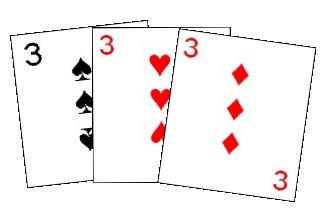 |
| The first play must contain the three of Spades either by itself or as part of a valid combination. |
|
For the first play of the first hand, the player may play any legal combination (either as a solo card or another combination), but it must contain the three of Spades.
After the first player makes his play, the turn rotates around the table in a counter-clockwise direction from player to player. The next player in turn attempts to play cards of a higher combination than that previously played to the table. His combination played must contain the same number of cards and be of the same type as that of the previous play. If he does not have (or does not want to play) such a higher combination, he must pass, and the turn moves to the next player in rotation who attempts to beat the combination. Cards are played face up to the center of the table such that all players can clearly see the card or card combination played. This will create a growing pile of cards in the center of the table as the players continue to make their plays. Play continues around the table from player to player, each attempting to play a higher combination of cards. When attempting to beat a previous card or combination, the higher combination played must consist of the same number of cards as the combination previously played and must be of the same type (such as sequence or triplet).
Once three consecutive players pass (not able or not wanting to play a higher combination of the same number of cards), the entire pile of cards in the center of the table is set aside, out of play. The individual who played the last high combination then starts the cycle again by playing any card or legal card combination to the center of the table. Since he is starting a new series of plays, the combination he plays may consist of any legal number of cards and is not required to be the same number of cards or type of combination as he had previously played. As before the players in turn then attempt to play a combination that can beat the last played. When a player passes on his turn, he must continue to pass until a new series of combinations is started after two other players have also passed.
At any time during the game a participant may ask any other participant how many cards they have left in their hand. The player asked must give an accurate answer.
Legal Combinations
The following table shows the complete list of playable combinations, grouped as to the number of cards in the combination. In order to beat the previous combination, a player may only play a combination of higher value consisting of the same number of cards and of the same type. For example, a three card run can only be beat by a higher ranked three card run.
| Combination | Description | Example |
|---|
| Solo | This is a combination consisting of a single card. When comparing two such solo cards, the marked ranking on the face of the card is used to determine which is considered the higher combination. For two cards of the same numerical denomination, a card of a higher ranked suit can beat a card of the same denomination of a lower ranking suit. | 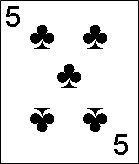 |
| Double | This is a two card combinations which always consist of a pair of cards of the same marked denomination. A pair of higher denomination cards will beat that of a lower denomination. A second pair of the same denomination can beat the previously played pair if one of its cards is of the suit of diamonds (highest ranked suit). | 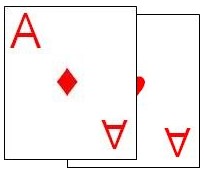 |
| Triple | A triple consists of three cards of the same denomination. Three matched cards of a higher denomination beat a triple of a lower denomination. | 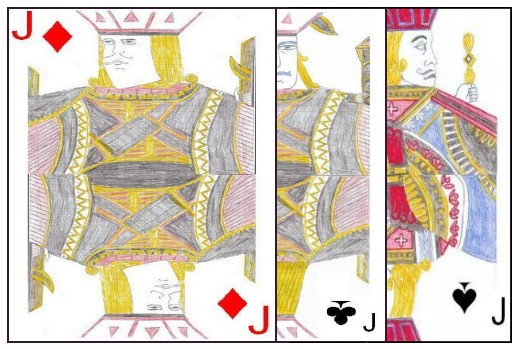 |
| Quad | This four card combination consists of all four of a particular ranked card, one in each suit. When comparing two such four of a kinds, the set consisting of higher numerically ranked cards is considered the higher combination. | 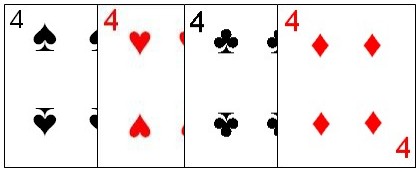 |
| Run | A run or sequence is a combination of three or more cards in direct numerical sequence. A sequence can be beaten only by a higher such sequence. A sequence is rated by the highest numerical card in the sequence. The highest ranked card allowed in any sequence is the Ace and the lowest a 3 (A run may never contain a 2). The cards in the sequence need not be all of the same suit, and being all in he same suit does not give the run a higher ranking. To beat such a sequence a player would need to play another sequence consisting of the same number of cards but with the highest card in the sequence being higher than that of the previous such sequence. If two sequences consist of the same cards, the one with the highest cards in the sequence being of a higher ranked suit would be considered the higher of the two. A sequence can only be beat by a higher sequence consisting of the same number of cards in the sequence. | 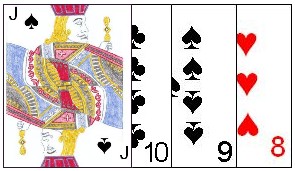 |
| Double Run | A double run or "finger" is a run consisting of three or more pairs that are in sequential numerical order. The sequence does not have to consist of all cards of the same suit. When comparing two such double runs, the highest is considered to be that which includes the highest pair. If the highest pair is the same, suit ranking would then be used to determine the higher double run. A double run may not contain a 2. | 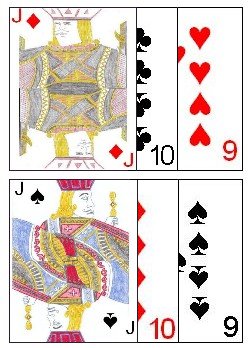 |
Bombs, Chops and Beating Twos:
Although in general a combination can only be beaten by a combination which contains the same number of cards and of the same type, there are several exceptions to this rule, as follows. These special combinations are also called bombs or chops, for the way they can be dropped on another, seemingly unbeatable combination, often consisting of twos. When used to beat twos a combination consisting of four of a kind is often called a bomb and a combination consisting of sequences of pairs, when used to beat twos is called a chop.
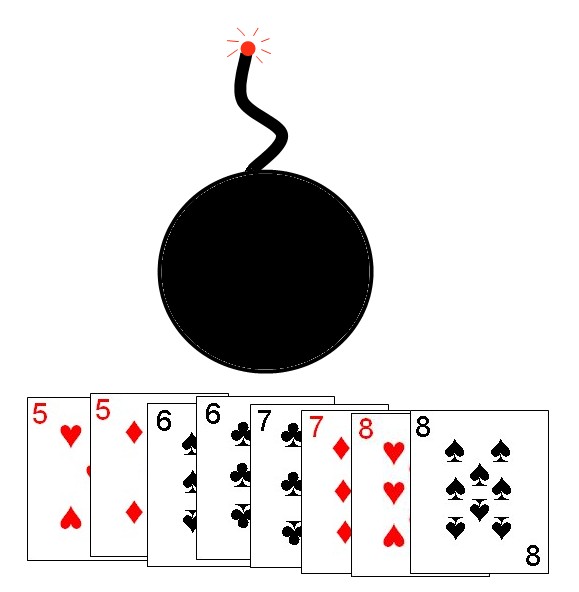
- A solo two, which is the highest solo ranked card, can be beaten by any four of a kind. This only applies to a solo two, and not any other solo card combination. The four of a kind played can be beaten by a higher four of a kind as normal.
- A four of a kind can also beat any three pair double run. This four of kind can be beaten by a higher such four of a kind.
- A three pair double run can also beat any solo two. This only applies to a solo two. After this is played, this three pair double run could be beaten by a higher such three card sequence.
- A four pair double run can beat any two or pair of twos. This only applies to twos, however, as this combination cannot be used to beat any other solo card or pair. After the double run is played, a higher ranked such four pair double run can be played to beat it.
- A four pair double run can also beat any four of a kind or three pair double run.
- A five pair double run, can beat any three twos. This only applies to three twos, and does not beat other triplets. Once played, a higher ranked five pair double run could beat the one played.
Once a player passes during a series of played combinations they may not make a play (including a bomb) until the next series of plays begins (unless they again pass in the new round).
Winning the Game
When a participant plays his last card to the center of the table in a legal combination he drops out of the hand, with continued play skipping this player as the turn rotates around the table. When all but one player has run out of cards the hand ends, with the last player to hold cards set as the loser of the game.
There are a wide variety of variations of Tien Len found at many card tables around the world. The following are some of the more popular and common such variations.
Viet Cong: This variation, also called VC, is a variation of Tien Len that is often played in the United States. The game is very similar to the standard game with the following differences:
- Twos may never be played as part of a run. Thus, the highest card allowable in a run is the Ace. However, twos may be played as part of a double run, and are considered the highest cards in the double run (i.e. Queen, Queen, King, King, Ace, Ace, 2, 2).
- On every hand the player holding the three of Spades always plays first. That player must always play the three either solo or as part of a larger combination on his first play.
- Any player who is dealt all four twos should show them immediately. The game ends immediately with this player being declared the winner.
- The normal bombs from the standard game are not used, and are instead modified with the following similar combinations that can beat twos, called slams:
- A three pair double run can beat a solo two, but no other solo card.
- A four of a kind can also beat a solo two. It cannot, however, be used to beat any other solo card.
- A five pair double run can beat any pair of twos. However, it cannot beat any pair BUT a pair of twos.
- Two consecutive four of a kinds can also be used to beat a pair of twos. This only applies to a pair of twos, however.
- A seven pair double run can beat any three twos. No other triplets can be beat in this way, however.
- Three consecutive four of a kinds can also beat a triplet of twos. However, it can not be used to beat any other type of triplets.
When a slam is used to beat two's, a higher combination of the same type and same number of cards can then beat the slam combination played.
In all other respects VC is played identically to the parent game it is derived from.
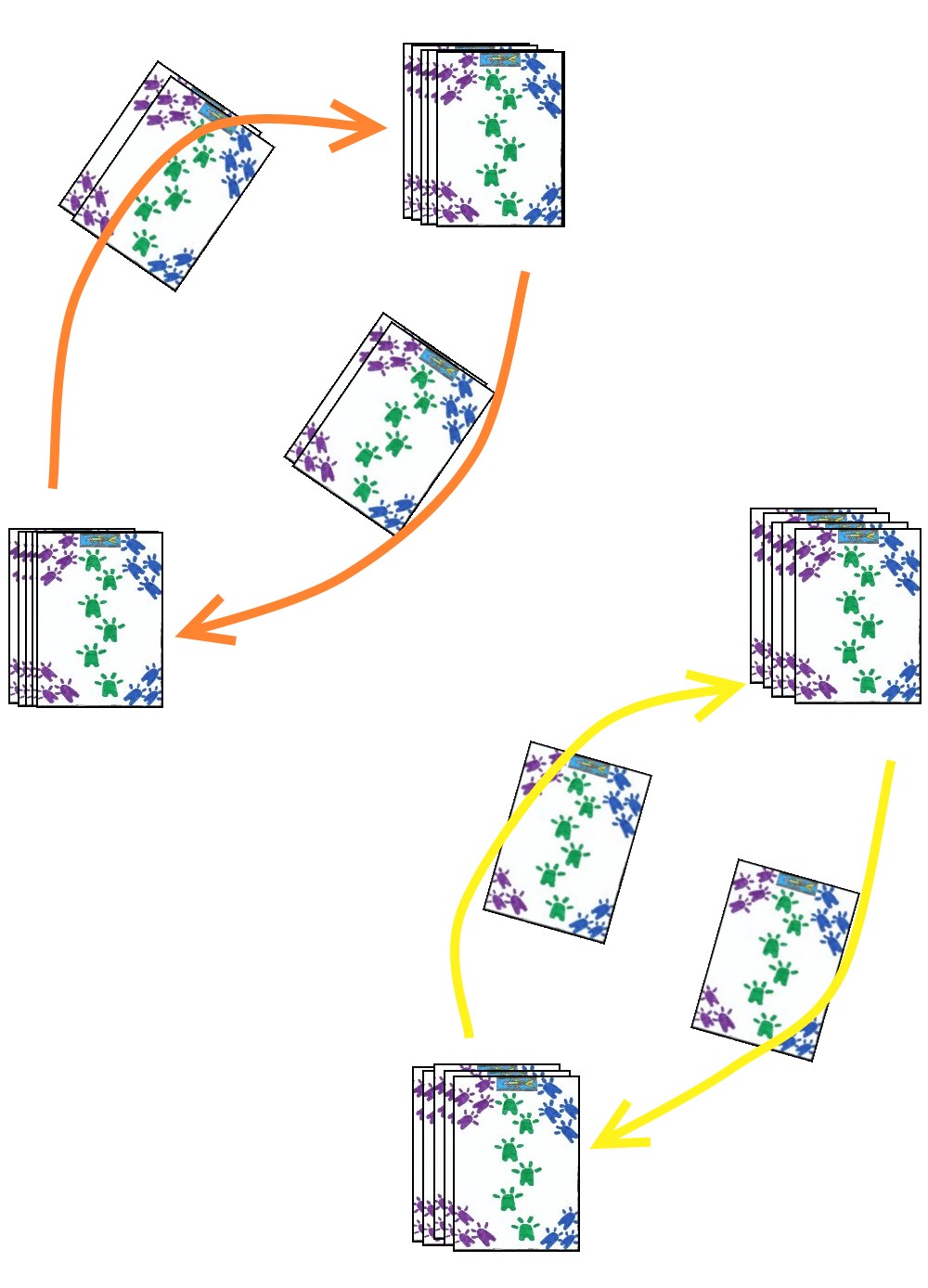 |
| After the first hand, the fourth place and first place players must exchange two cards and the second place and third place players exchange one. |
Card Trading:
Another rule that is sometimes added to Tien Len is that of card trading. When this rule is used, the loser of the last hand must give his two highest cards to the winner of the previous hand. In return, the winner gives this player any two cards of his choice. A similar trade also occurs between the second and third players from the previous hand, with the second player receiving the highest card held by the third player in exchange for any card of the second winners choice. Obviously, on the first hand of every game no card trading occurs. When the card trading variant is used, instant wins are not usually counted (including holding 4 deuces).
More Instant Wins: In addition to the normal rule of four twos resulting in an instant win for the holder, sometimes the following additional combinations, when held by a player also result in an instant win for that participant:
- A double run consisting of six consecutive pairs.
- Three consecutive triples
- A complete sequence running from the three all the way to Ace and Deuce. The 12 card sequence need not contain all cards of the same suit.
In the rare instance when more than one player has a combination of cards that could result in an instant win, the ranking of the instant win types is as follows (from low to high): Double run of six pairs, Three consecutive triples, Complete sequence, four Twos. If two players hold the same classification of instant win hand, the normal rules for comparing these types of combinations is used (highest denomination of card in the combination and then suit ranking). Before the hand begins the player holding such a hand should display it and is instantly declared the first winner of that hand.
Additional Playable Combinations
Many of the variations of Tien Len revolve around the addition of playable combinations. Some of the more common such additions found at Tien Len games are as follows:
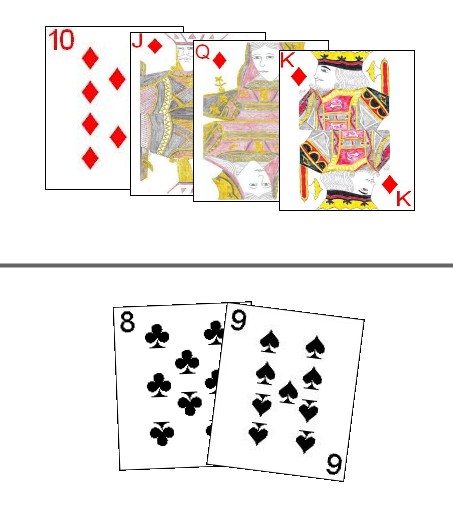 |
| Additional combination types are sometimes added in Tien Len, such as Suited Runs and Two card sequences. |
Suited Runs: Similar to a normal run, however a suited run consists of 3 or more cards in sequence, all of the same suit. This is considered a different combination type than a regular run, so if a player leads with this combination, any other player attempting to beat the combination can only beat it with a higher suited run consisting of the same number of cards. When comparing two suited runs, the combination containing the highest denomination card is considered the higher. When comparing two suited runs consisting of the same denomination of cards, the run in the higher suit is considered higher. A player may play a suited run in response to a regular run, but when played in such a manner, it is considered only a regular run with no special ranking for being a suited run in that case.
Two Card Runs: Some games allow the addition of two card runs. This consists of two cards in sequence. The cards are not required to be in the same suit. As with longer Runs, a two card run can be beat by a higher two card sequence. If comparing two such sequences that contain the same cards, the suit of the higher card in the sequence can be further used to rank the two card run.
Twos used in Runs: Although most versions of Tien Len do not allow 2's to be contained in runs or double runs, some variations allow their inclusion. If this rule is adopted, the 2 is considered the highest allowable card in the run.
Tien Len for Differing Numbers of Players: Although most commonly played as a game for four, there are also variations of this game designed for 2, 3, 5 or more players. Variations for these differing number of players is described below.
In any version of this game where there are extra cards not distributed to the players, the three of Spades may not be in play. In this case, the player with the lowest card in hand would have the first play in the first hand. To determine this, the dealer will sometimes begin calling out the lowest ranking cards in the deck (starting with the three of Spades and continuing to name cards in ascending order from the three of Spades up). The first player (including the dealer) to possess a card the dealer names would state this, and then would be entitled to the first play of the hand.
- Tien Len for Two Players: Tien Len is also often played by two players. The rules are identical except that after each player is dealt the normal thirteen cards, there will be cards remaining in the deck. This stack should be set aside and unused in the hand.
- Tien Len for Three: This game can also be played by three players, similarly to the standard version. Each player would receive 17 card hands, with the last card in the deck set aside face down and not used in the hand. The game itself is played the same as the four player version of Tien Len.
- Tien Len for Five or More: This game is also sometimes played by five or more players (up to eight players). When playing with 5 or more, two standard 52 card decks are shuffled together to be used for the game. This larger deck is then shuffled, cut and each player would receive thirteen cards. Any remaining cards in the deck would be set aside and unused for the remainder of the hand. When using a double deck there will be more potential for identical combinations. A combination can never be beaten by another combination consisting of the exact same cards (rank and suit), but must be higher in some respect.
Copyright © 2015
CatsAtCards.com. All rights reserved.









